
Tetraodontidae is a family of primarily marine and estuarine fish of the order Tetraodontiformes. The family includes many familiar species variously called pufferfish, puffers, balloonfish, blowfish, blowers, blowies, bubblefish, globefish, swellfish, toadfish, toadies, toadle, honey toads, sugar toads, and sea squab. They are morphologically similar to the closely related porcupinefish, which have large external spines. The scientific name refers to the four large teeth, fused into an upper and lower plate, which are used for crushing the hard shells of crustaceans and mollusks, their natural prey.

Canthigaster is a genus in the pufferfish family (Tetraodontidae). A fish from this genus is sometimes referred to as a "toby" or a "sharpnose puffer".

Gymnothorax is a genus of fish in the family Muraenidae found in Atlantic, Indian and Pacific Ocean. With more than 120 species, it the most speciose genus of moray eels.

The map puffer, also known as the map pufferfish, scribbled pufferfish, or Kesho-fugu, is a demersal marine fish belonging to the family Tetraodontidae. The map puffer is typically found in tropical and subtropical waters from the Indian Ocean to the western Pacific Ocean. This fish contains tetrodotoxin, a potent and deadly chemical compound used to ward off predators. Despite being highly poisonous, the map puffer can be found both in the aquarium trade and certain food markets.
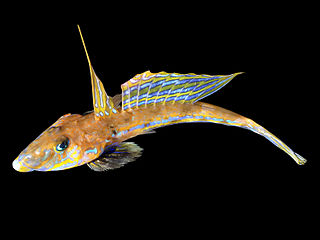
Callionymus is a genus of dragonets found mostly in the Indian and Pacific oceans with a few species occurring in the Atlantic Ocean.
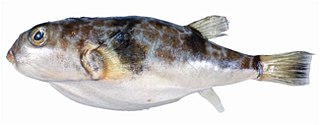
Reicheltia halsteadi, Halstead's toadfish, is a species of pufferfish endemic to Australia. This species grows to a length of 16 centimetres (6.3 in) TL. This species is the only known member of the genus Reicheltia.
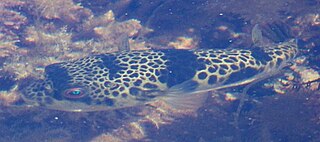
Tetractenos is a genus of Tetraodontidae. The genus can be found throughout the Indo-West Pacific and Australia's southern and eastern coastlines.
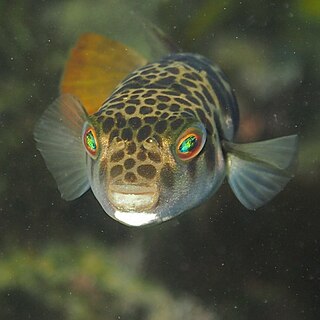
The smooth toadfish is a species of fish in the pufferfish family Tetraodontidae. It is native to shallow coastal and estuarine waters of southeastern Australia, where it is widespread and abundant. French naturalist Christophe-Paulin de La Poix de Fréminville described the species in 1813, though early records confused it with its close relative, the common toadfish. The two are the only members of the genus Tetractenos after going through several taxonomic changes since discovery.
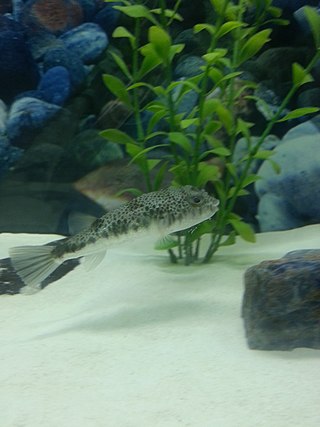
The common toadfish, also known as the common toado, toadfish or toado, is a species of fish in the family Tetraodontidae of order Tetraodontiformes, found along Australia's eastern coast, from northern Queensland to Flinders Island, and around Lord Howe Island, as well as in New Zealand waters. It often buries itself in sand with only its eyes exposed.

Ostorhinchus is a genus of ray-finned fish in the family Apogonidae native to the Indian and Pacific Oceans.
Torquigener albomaculosus, or the white-spotted pufferfish, is the 20th discovered species of the genus Torquigener. The species was discovered in the ocean waters around the Ryukyu Islands in Japan off the south coast of Amami Ōshima Island. Observed depths of the species range between 10 and 27 m. The fish's head and body are colored brown with white spots at the back. Its abdomen is silvery-white with white spots.

Torquigener pleurogramma, commonly known as the weeping toadfish or blowie, is a species of fish in the family Tetraodontidae. It is found in the coastal waters of Australia. Its flesh is highly toxic.
Torquigener andersonae, commonly known as Anderson's toadfish, is a species of fish in the family Tetraodontidae. It is found in the coastal waters of southeastern Australia. It was described by Graham Hardy in 1983, who named it for a colleague at the University of New South Wales, Dr. Jennifer M. E. Anderson. It has been recorded from Jervis Bay and Bermagui on the southern New South Wales coast.
Torquigener squamicauda, commonly known as the brush-tail toadfish or scalytail toadfish, is a species of fish in the family Tetraodontidae. It is found in the coastal waters off eastern Australia from Yeppoon in Queensland to Wattamolla just south of Sydney in New South Wales.
Torquigener altipinnis, the highfin toadfish, is a species of fish in the family Tetraodontidae. It is found in the coastal waters off eastern Australia, from southeast Queensland to Malabar, New South Wales, as well as Norfolk, Lord Howe and Raoul Islands.
Torquigener perlevis, commonly known as the spineless toadfish, is a species of fish in the family Tetraodontidae. It is found in the coastal waters off northern and eastern Australia from the Gulf of Carpentaria to the Georges River and Botany Bay in Sydney, New South Wales.
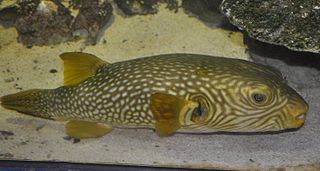
Arothron reticularis, variously known as the reticulated pufferfish, reticulated blowfish or reticulated toadfish, is a ray-finned fish in the family Tetraodontidae. It is native to the tropical and sub-tropical Indo-Pacific region where its habitats include sandy and muddy seabeds, coral reefs, estuaries and mangrove areas.
Whitley's toadfish is a species of fish in the family Tetraodontidae that reaches a length of 9.8 cm, and is a host to Bianium plicitum.
The white-spotted pufferfish is known for its unique and complex courtship display which involves creating large, geometric circles in the sand. These circles are constructed in an effort to attract females for copulation. Males must maintain their circles in order to attract a mate. A female will evaluate the structure and choose to mate with the males after evaluation and completion of other mating behaviors.

Chelonodontops patoca, also known as the milk-spotted pufferfish, milkspotted puffer, milkspotted toadfish, Gangetic blow fish, Gangetic pufferfish, or marbled toad, is a species of pufferfish in the family Tetraodontidae native to the Indo-Pacific. It ranges from East Africa to the Western Pacific from Korea in the north to northern Australia in the south. It is a tropical species that occurs in coastal waters, lagoons, estuaries, and rivers. While it does enter fresh water, the species does not occur more than a few kilometres from the sea. It is often seen in schools which sometimes enter freshwater streams. It is usually found at a depth range of 4 to 60 m and reaches 38 cm (15 in) standard length. The species is poisonous but reportedly considered a delicacy in Japan.













